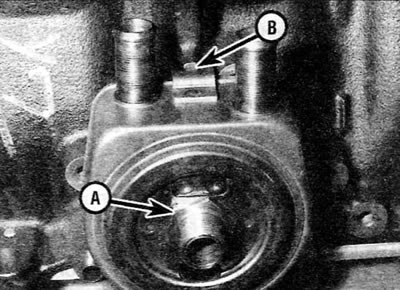Removing
1. Fully apply the parking brake. Raise the front of the vehicle and securely jack stands under it (see «Lifting and placing the car on supports»).
2. Drain the coolant from the cooling system as described in the chapter. Alternatively, pinch the oil cooler coolant hoses directly over the radiator and be prepared for some coolant to come out when the hoses are disconnected.
3. Place a suitable container under the oil filter. Unscrew the filter, using the oil filter removal tool if necessary, and drain the oil into a container. If the oil filter was damaged or deformed during removal, it should be replaced. Given the low cost of a new oil filter compared to the cost of repairing the damage that can result if a reused filter leaks, it is recommended that the filter be replaced as a matter of course.
4. Release the hose clamps and disconnect the coolant hoses from the oil cooler.
5. Remove the oil cooler/oil filter mounting bolt from the cylinder block, and remove the oil cooler. Notice the alignment groove in the radiator flange that mates with the lip on the cylinder block (pic. 19.5). Discard the oil cooler O-ring; when installing, use a new one.

Pic. 19.5. Mounting bolt (A) and mounting groove (IN) oil cooler/oil filter
Installation
6. Install a new O-ring to the notch at the rear of the radiator, and then bring the radiator to the cylinder block.
7. Make sure that the mounting groove in the radiator flange is correctly engaged with the protrusion on the cylinder block, then screw in the appropriate bolt and tighten it securely.
8. Install the oil filter. Lower the car. Top up the engine oil level as described in «weekly checks».
9. Top up the cooling system or top up the coolant level as described in chapter 1B or «weekly checks». Start the engine and check the oil cooler for signs of leakage.
